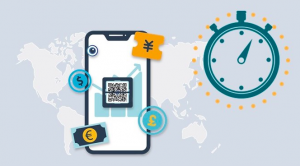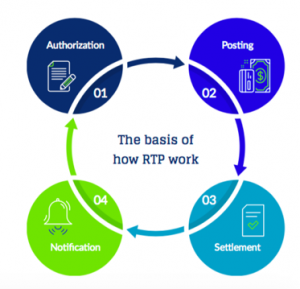
The payments industry is fuelled by speed and innovation, and with the seismic shift in consumer and business behaviours, the pace of digital adoption has accelerated. Customer demand for quick payments has driven the need for improving existing payment rails with real-time settlement. Real-time payments (RTP) is the most significant financial innovation of the decade, representing speed and innovation, boosting micro digital economies. RTP has immense potential to serve under-banked societies in areas where bank branches don’t exist. Thus far, 56 nations have enabled RTP, opening the door to a wealth of value-added services driving bank revenues. The transaction volume of real time payments in the US is expected to increase from $734 million to $4.2 billion by 2024, due to a pressing need to decrease the dependence on traditional payments mechanisms. As such, 77% of merchants expect RTP to replace physical payment cards. Real time payments aim to bring efficiency, security and transparency to an industry that is centred around these core values, prompting its popularity.
What Are Real Time Payments?
Due to the rise in digitalised preferences, it is predicted that ½ trillion of RTPS will be processed by 2025. Real time payments are an international standard for financial business process communications, creating money movement efficiencies. Real time payment systems involve technology that enable instant money transfers between banks and banking systems, with funds made 365 days, 24/7. The real time processing of these payments involved 4 steps as seen below in figure 1. With RTP, experiences are improved by frictionless interactions.

Figure 1: The Basis of How RTP Works (Imburse Payments)
The pandemic caused a myriad of unpredicted challenges that changed the face of the payments industry. Cash is no longer king, whilst it is considered as an instant form of payment, the pandemic accelerated the pace of digitisation, and with that consumer demand for RTP is also on the rise. As such the expediency in payments became even more critical. RTP networks allow banks and other financial institutions to clear and settle payments in real-time and create and deliver new innovative products and services in real time. The RTP market accounts for more than 89% of global GDP with over 5,000 institutions globally connected to RTP systems.
Speed:
After COVID-19, liquidity management at every level has remained crucial to economies, with vibrant digital economies requiring the real-time movement of money. The outdated legacy systems that economies have relied on, prevent banks from addressing customer expectations for a faster and more flexible way to transact. Due to technological change, consumers expect a mobile-first and real-time experience. Payments made with credit and debit cards, or even with digital wallets are not processed immediately, taking up to 72 hours. The lack of real-time money movement ends up making things more expensive. RTP allows for a faster and safer payment processing experience, giving real time notifications on payment history and settlements that cash can’t.
With the increase in consumer and business expectations for an on-demand, RTP is growing. Real time payments solve both professional and personal needs, delivering payments that could happen in less than 30 seconds. Institutions harness the RTP infrastructure to deliver innovative products. Real time payments provide certainty of payments and real-time visibility of balances. The presenting financial institutions with the opportunity to enhance product offerings, it generates new revenue streams and improves the life of the end-user. The RTP system provides a means to migrate to a vibrant and secure digital payments ecosystem.

Transparency:
In a world where businesses expect speed, precision and transparency, RTP puts them in the financial driver’s seat. Real time payments bring end-to-end communication. Traditionally, if a payer and payee want to exchange information back and forth, they must do outside a payment system. RTP connects the payment and payment data together in a single transaction. With RTP, pain points are addressed, eliminating uncertainties around settlements and cutting out error. The speed and transparency from information flows within a RTP system, providing instant payment confirmation notifications and settlement. The business and consumer experience around RTP allows for an efficient payment journey.
Security:
Security, speed and ubiquity are critical facets of a modern payment hub. Real time payments function as a proxy for trust, helping make customers experience more seamless and intuitive. Whilst real time payments are instant, they also mean real-time theft. No passenger wants to travel faster without assurance that they are travelling safely. As such, compliance processed need to be up to sped up to meet global business expectations. RTP promise instant settlements and build end-to-end channels to improve clarity and transparency for payment communications. Within RTP systems, identity verification and authentication methods are integrated ensuring maximum security for payments. Many RTP networks have taken a step further in ensuring security by setting transaction limits and sending notifications of payment confirmation. Australia’s new payment platform requires 95% of its transactions to be responded within 15 seconds. Furthermore, for banks, RTP is able to help with fraud checks by enabling multi-factor authentication and targeted scanning.

Changing The Nature of The Payments Industry:
Real time payments change the way we conduct business, with consumers enjoying the convenience of paying their bills last minute without penalties, businesses benefiting from an increased availability of funds and financial institutions providing better services. RTP gained a strong foothold in payment processing. 75% of organisations experienced customer gains from real time payments due to the increased customer satisfaction and retention. A Deloitte report indicated that 77% of merchants believe that real time payments can replace physical payments. This can be seen in 2019, when digital online payments surpassed credit cards by payment volume, reaching $4.1 trillion. With real time payments, payments can be initiated from existing accounts and received in seconds, allowing for easy, predictable and improved cash flow management. This further translates into improved budgeting, financial projections and cash management.